 They say you drive for show and putt for dough, so that would make the putter many player’s “money club,” right? This week, we’re going to look at famous money clubs.
They say you drive for show and putt for dough, so that would make the putter many player’s “money club,” right? This week, we’re going to look at famous money clubs.
Putters, as we all know, come in many shapes and sizes. Putters can be shaped like Futura Phantoms or the Ping Docs and look perfectly normal sitting next to a Ping Answer or a Bullseye. Putters may be the most personal instrument in a player’s bag, with everything from the lie angle, face angle, grip, shaft length, and weight coming into play and combining to give that magical sensation – feel – to the player.
When the tournament is on the line, what famous putters stroked some famous putts? Find out in this week’s edition of Trap Five.
Number Five: PING
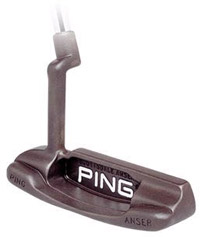 Karsten Solheim was a General Electric engineer and a golf nut. His engineering background and his passion for golf combined in his Phoenix garage where he began working on his putting game not by practicing his stroke, but by creating a new putter. Though he made several playable prototypes, only one made it out of his garage in the end: the original PING putter, so named because of the sound the putter made when it struck a golf ball.
Karsten Solheim was a General Electric engineer and a golf nut. His engineering background and his passion for golf combined in his Phoenix garage where he began working on his putting game not by practicing his stroke, but by creating a new putter. Though he made several playable prototypes, only one made it out of his garage in the end: the original PING putter, so named because of the sound the putter made when it struck a golf ball.
Solheim’s Anser putter – a revision of the original PING – was used by Julius Boros to win the Phoenix Open in 1967, and sparked a trend that’s continued to this day: heel-toe weighting in putters (and perimeter weighting in all other clubs). Solheim’s PING putters spread the weight towards the heel and toe to minimize distance loss on off-center hits, effectively enlarging the sweet spot. Almost every putter today uses heel-toe weighting.
Number Four: Wilson 8802
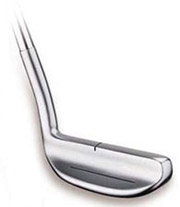 Arnold Palmer made it famous, but one of the best putters of all time – Ben Crenshaw – elevated the Wilson 8802 to a special place in golf’s history. Nicknamed “Little Ben,” Crenshaw’s 8802 was with him through all of his major victories, including the improbable one in 1995. Said Crenshaw’s dad, “It was just a putter in Harvey Penick’s shop. Ben felt it and waggled it around for a while. ‘Dad, I’d like to have it,’ he said, so I bought it for him. That club’s been the best provider in the family.” The putter cost Crenshaw’s dad $20.
Arnold Palmer made it famous, but one of the best putters of all time – Ben Crenshaw – elevated the Wilson 8802 to a special place in golf’s history. Nicknamed “Little Ben,” Crenshaw’s 8802 was with him through all of his major victories, including the improbable one in 1995. Said Crenshaw’s dad, “It was just a putter in Harvey Penick’s shop. Ben felt it and waggled it around for a while. ‘Dad, I’d like to have it,’ he said, so I bought it for him. That club’s been the best provider in the family.” The putter cost Crenshaw’s dad $20.
The 8802 is a simple putter with no heel-toe weighting to speak of and a very clean, simple look. Its design may have been inspired by Calamity Jane (see below), and it won nearly as many majors. Arnold Palmer used the 8802 (and a small revision, the 8813) to win several of his majors, and Phil Mickelson has always seemed to putt best with his remake (currently made by his sponsor Callaway – i.e. Odyssey) of the venerable 8802.
Number Three: Calamity Jane
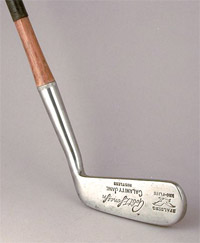 Arguably the U.S.’ most famous golfer (Jack Nicklaus and Tiger Woods being the only real competition), Bobby Jones mastered golf long before The Masters came to be. His putter, nicknamed Calamity Jane, was a simple offset blade putter forged by Condie and sold by William Winton. The putter was almost 20 years old and already had its famous nickname when it was given to Jones in 1920. Jones replaced the original in 1926 with a duplicate known as Calamity Jane II (and mmade by Spalding). Jones won the last 10 of his major championships with Calamity Jane II and later gave the putter to the USGA Museum. The original remains on display at Augusta National Golf Club.
Arguably the U.S.’ most famous golfer (Jack Nicklaus and Tiger Woods being the only real competition), Bobby Jones mastered golf long before The Masters came to be. His putter, nicknamed Calamity Jane, was a simple offset blade putter forged by Condie and sold by William Winton. The putter was almost 20 years old and already had its famous nickname when it was given to Jones in 1920. Jones replaced the original in 1926 with a duplicate known as Calamity Jane II (and mmade by Spalding). Jones won the last 10 of his major championships with Calamity Jane II and later gave the putter to the USGA Museum. The original remains on display at Augusta National Golf Club.
After winning the Grand Slam in 1930 and retiring, Jones began consulting for Spalding – at that time a clubmaking giant. From 1932 to 1973, Spalding produced a line of clubs under Bobby Jones’ name. Dozens of Calamity Jane models in both hickory and steel shafts were made in those 40+ years, but none contained the magic of the original and none won a major of their own.
Number Two: Schenectady
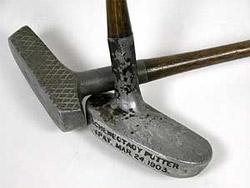 Walter Travis, an American golfer in the early 1900s, was deadly with his putter. So deadly in fact that he mastered the tricky British Amateur greens and became the first American to win the British Amateur in 1904. His putter? The “Schenectady,” named by inventor Arthur F. Knight after his hometown in upstate New York.
Walter Travis, an American golfer in the early 1900s, was deadly with his putter. So deadly in fact that he mastered the tricky British Amateur greens and became the first American to win the British Amateur in 1904. His putter? The “Schenectady,” named by inventor Arthur F. Knight after his hometown in upstate New York.
Having sinned against all of Britain by helping Travis hole putts from everywhere in 1904, the Royal & Ancient promptly banned the putter from all competitions – a ban which lasted until 1952. Though the official reason given was that the putter was considered a “mallet-headed type” similar to a center-shafted croquet mallet, the real reason was quite evident to all who witnessed or heard of Travis’ performance that year.
Travis’ actual Schenectady putter may have been lost to the sands (or greens) of time: its exact whereabouts are unknown at this time.
Number One: Odyssey Dual Force Rossie 2
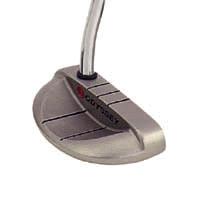 Nick Faldo seems a rather unassuming fellow, and hardly one associated with putting. Though he “putted for dough” quite frequently, winning six majors, it was his superb accuracy and calm under pressure that set him apart.
Nick Faldo seems a rather unassuming fellow, and hardly one associated with putting. Though he “putted for dough” quite frequently, winning six majors, it was his superb accuracy and calm under pressure that set him apart.
One of Faldo’s six majors occurred in the 1996 Masters, the year of Greg Norman’s historic collapse. Faldo’s putter that week was the unassuming Odyssey Dual Force Rossie 2, a mallet-shaped putter with an S-bend shaft. Both of those features were (and remain) fairly common, but the Rossie was the first putter with an insert. We see inserts in putters today, including just about every Odyssey putter (including the White Hot 2-Balls).
The insert and Faldo’s win caused such a stir that golf shops couldn’t keep up with orders for months to come. Players at the Senior PGA Championship a week after the Masters in 1996 had to buy their own Rossies from the pro shop because the Odyssey rep ran out of putters. Odyssey was later purchased by Callaway for a tidy $130M.
Just Missing the Cut
The Bullseye, used by Corey Pavin to win the 1995 U.S. Open and often by Tom Kite (as well as many other players) is a classic putter. What’s best is that you can still find this putter today.
The George Low Sportsman Wizard 600 was used by Jack Nicklaus for many – but not all – of his majors. Jack was always known for his putting, but his success didn’t sell a ton of Wizard 600s.
The Odyssey Two-Ball has been used by every serious golfer – at least on the practice green when borrowed from a friend – since it was introduced a few years ago. Its design has been copied by many, but the original and subsequent revisions remain the most popular.
Next Week
I’m not sure what we’ll count down next week, but feel free to leave suggestions in the comments (below).

I have a Calamity Jane putter that was owned/used by Sam Snead. My father’s uncle was Arnold Browing a golf pro at Guyan Country Club in Huntington, W Va. The story my Dad told me was Sam got mad and broke the putter and then gave it to my uncle, he then put a small nail in it to fix. He gave it to my Dad who gave it to me when I was 15. I have had the club for about 45 years.
The Odyssey was far from the first putter with a face insert and not the first to win a major. Face inserts are over 100 years old and Gary Player and Peter Thomson both won majors with George Low Wizard 300s with Delrin inserts. Also Crenshaw used a Cleveland “Designed by Ben Crenshaw” putter to win the 1995 Masters, not an 8802.